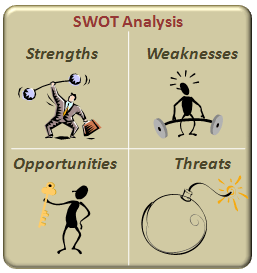What’s the SWOT?
When you’re running your own practice, you are so much more than “just” a lawyer. You  also have to be a manager, a planner, and a marketer. All of these roles take a different set of skills, and to be successful, you need to have at least a basic knowledge of each. In some cases, though, there is a single thing you can do that works for all these different categories. One of the activities you can, and should, do in order to be a better manager, planner, and marketer is to identify your business’ S.W.O.T.
also have to be a manager, a planner, and a marketer. All of these roles take a different set of skills, and to be successful, you need to have at least a basic knowledge of each. In some cases, though, there is a single thing you can do that works for all these different categories. One of the activities you can, and should, do in order to be a better manager, planner, and marketer is to identify your business’ S.W.O.T.
The S.W.O.T. is a part of strategic planning that helps to identify where your business is now and help steer it in the right direction for the future. It takes some work on your part, but by the time you’re done, you’ll likely have identified several areas that you can use to bolster your marketing plan. Sharing what you’ve learned with your employees also works to make sure that everyone is on the same page and working toward the same goals.
So, what is the S.W.O.T?
S = Strengths: When you look at your business as objectively as possible, what do you feel your strengths are? Perhaps you have specialization that sets you apart from other attorneys in the area. Maybe you are great at “hand-holding” new clients who are intimidated by the legal process. Spend some time and come up with at least five strengths and put some thought into how you can leverage them in your marketing to really shine.
W = Weaknesses: It’s not necessarily fun to look at your own flaws, but when you do it from an objective perspective, it can be a really powerful exercise. Weaknesses are those things that you want to target for elimination. For example, maybe you are having trouble keeping up with the workload and some things are falling through the cracks. By writing this down, you can give yourself permission to find a solution, such as realizing that it’s time to hire some help.
O = Opportunities: Uncovering opportunities for your business is one of the most enjoyable parts of the S.W.O.T. process. Opportunities are things that you want to capitalize on, either now or in the future. Are there services that are lacking in your area that you could add to your practice? Do you have ideas for a referral system that could pay off? It might be helpful to lay out all of your opportunities with some deadlines and milestones for making them into reality.
T = Threats: Threats are those things that could negatively impact your business but that you don’t have any direct control over. For example, are there some changes in the law coming up that may cost you clients? Is a rough economy a problem when it comes to building your client list? The point of listing your threats is to give yourself the chance to monitor them and find ways to mitigate their impact.
Realistically, it doesn’t have to take a ton of time to do a cursory S.W.O.T. analysis. The important part is that you take that time to identify what is working for and against you so that you can take steps to capitalize on that knowledge.
Would you like to talk about how we can help you save time on your marketing and help you turn ideas into action? Simply schedule a time on my calendar for a no-strings virtual cup of coffee.
